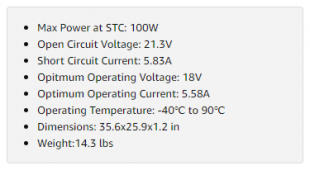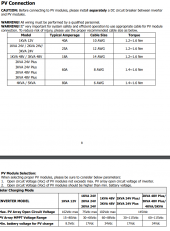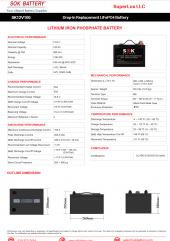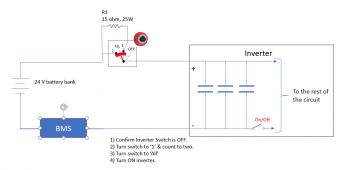Hi all,
Completely new to solar systems and electrical in general, I've been working on designing a small/basic system for our mountain cabin. I had been researching and designing a system from individual components but am now thinking about going the all-in-one route just for simplicity's sake. Here's what I'm looking at using:
2 x 100Ah LiFePo4 batteries (SOK) in series for 100Ah 24V battery bank
4 x 100W mono panels (HQST) in series
Growatt 24V SPF 3000TL LVM
The cabin will be unoccupied and below freezing for the majority of the winter besides the handful of weekends we're out there. My thought was just to top off the bank when leaving (will have a generator if needed) and disconnect them from all loads and panels to completely shut down the system. When we come back out we wouldn't turn on the system until we'd warmed up the cabin via woodstove to avoid any battery damage from cold temps or any other electrical issues while it's unoccupied for weeks to a month or two at a time. I'd probably do the same shut down process in the summer as well if we're not planning on coming back soon just for peace of mind.
A few questions:
1) Is that size battery bank large enough to power the inverter? I don't think we'd ever pull anywhere near the max watts but I've been told the bank still needs to be sized accordingly so that the BMS doesn't trip when the inverter capacitors are charging up.
2) Is that a good balance of panels for the system? Panels are cheap but I've read discussions where people have too much panel for the bank (don't know what C/x rate is ideal for battery health or how that is calculated). I don't want to go crazy but I'd like to make sure it charges relatively quckly.
3) Do I gain anything by going with 2 x 200W 24V panels rather than 4 x 100W panels? Mounting space isn't an issue. I haven't been able to figure out if that really changes anything. Total series voltage seems more or less the same, and is well under what the Growatt is rated for even if it's well below freezing.
4) Should I only top the batteries off to the 75-80% SOC range for improved longevity? I've read that a cycle rate between 75%-25% SOC or similar will get a longer overall battery life than 100%-50%. The storage is oversized for what I realistically need 99% of the time so I'd be fine not having them at 100% ever, but I wasn't sure if storing them for weeks/months and less than 100% affects the batteries negatively at all like lead acid. My goal would be to do whatever is best for long term battery life to get the most bang for my buck over the life of this system.
5) Can I add a separate low temp shut off to my system so I'm not relying 100% on the battery BMS should the temperatures drop in the cabin while the system is on? I couldn't find where the Growatt manual ever referenced low temp shut off so I'm assuming it does not have it. It gets cold up there, so I'd like to do everything I can to protect my batteries. That seemed like one of the only drawbacks of going this route vs individual components and getting a high quality controller.
I've tried to do my homework and it seems pretty straight forward using the Growatt, but I'm brand new to this so I'd love to make sure I'm not missing something basic. The system will primarily just be for low voltage lighting (wired off a separate fuse box from the battery), charging handheld devices, and occasional charging of power tool batteries or running a single corded tool at a time. We'd also have a generator if we needed for large tools or crazy loads.
Thanks in advance for any/all feedback! Don't know what I would do without YouTube and these forums. I've learned a lot these last couple weeks (hopefully).
Completely new to solar systems and electrical in general, I've been working on designing a small/basic system for our mountain cabin. I had been researching and designing a system from individual components but am now thinking about going the all-in-one route just for simplicity's sake. Here's what I'm looking at using:
2 x 100Ah LiFePo4 batteries (SOK) in series for 100Ah 24V battery bank
4 x 100W mono panels (HQST) in series
Growatt 24V SPF 3000TL LVM
The cabin will be unoccupied and below freezing for the majority of the winter besides the handful of weekends we're out there. My thought was just to top off the bank when leaving (will have a generator if needed) and disconnect them from all loads and panels to completely shut down the system. When we come back out we wouldn't turn on the system until we'd warmed up the cabin via woodstove to avoid any battery damage from cold temps or any other electrical issues while it's unoccupied for weeks to a month or two at a time. I'd probably do the same shut down process in the summer as well if we're not planning on coming back soon just for peace of mind.
A few questions:
1) Is that size battery bank large enough to power the inverter? I don't think we'd ever pull anywhere near the max watts but I've been told the bank still needs to be sized accordingly so that the BMS doesn't trip when the inverter capacitors are charging up.
2) Is that a good balance of panels for the system? Panels are cheap but I've read discussions where people have too much panel for the bank (don't know what C/x rate is ideal for battery health or how that is calculated). I don't want to go crazy but I'd like to make sure it charges relatively quckly.
3) Do I gain anything by going with 2 x 200W 24V panels rather than 4 x 100W panels? Mounting space isn't an issue. I haven't been able to figure out if that really changes anything. Total series voltage seems more or less the same, and is well under what the Growatt is rated for even if it's well below freezing.
4) Should I only top the batteries off to the 75-80% SOC range for improved longevity? I've read that a cycle rate between 75%-25% SOC or similar will get a longer overall battery life than 100%-50%. The storage is oversized for what I realistically need 99% of the time so I'd be fine not having them at 100% ever, but I wasn't sure if storing them for weeks/months and less than 100% affects the batteries negatively at all like lead acid. My goal would be to do whatever is best for long term battery life to get the most bang for my buck over the life of this system.
5) Can I add a separate low temp shut off to my system so I'm not relying 100% on the battery BMS should the temperatures drop in the cabin while the system is on? I couldn't find where the Growatt manual ever referenced low temp shut off so I'm assuming it does not have it. It gets cold up there, so I'd like to do everything I can to protect my batteries. That seemed like one of the only drawbacks of going this route vs individual components and getting a high quality controller.
I've tried to do my homework and it seems pretty straight forward using the Growatt, but I'm brand new to this so I'd love to make sure I'm not missing something basic. The system will primarily just be for low voltage lighting (wired off a separate fuse box from the battery), charging handheld devices, and occasional charging of power tool batteries or running a single corded tool at a time. We'd also have a generator if we needed for large tools or crazy loads.
Thanks in advance for any/all feedback! Don't know what I would do without YouTube and these forums. I've learned a lot these last couple weeks (hopefully).









